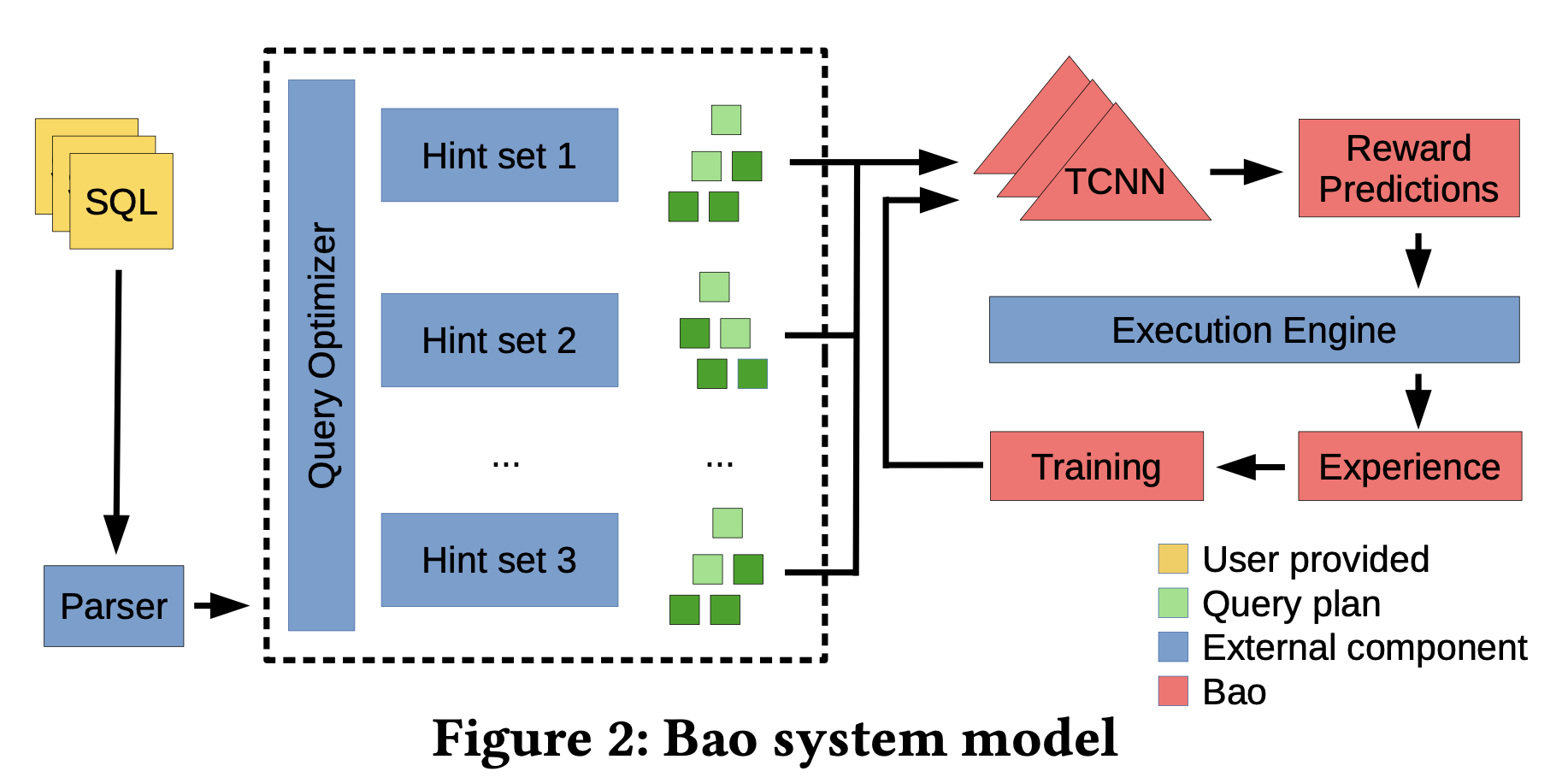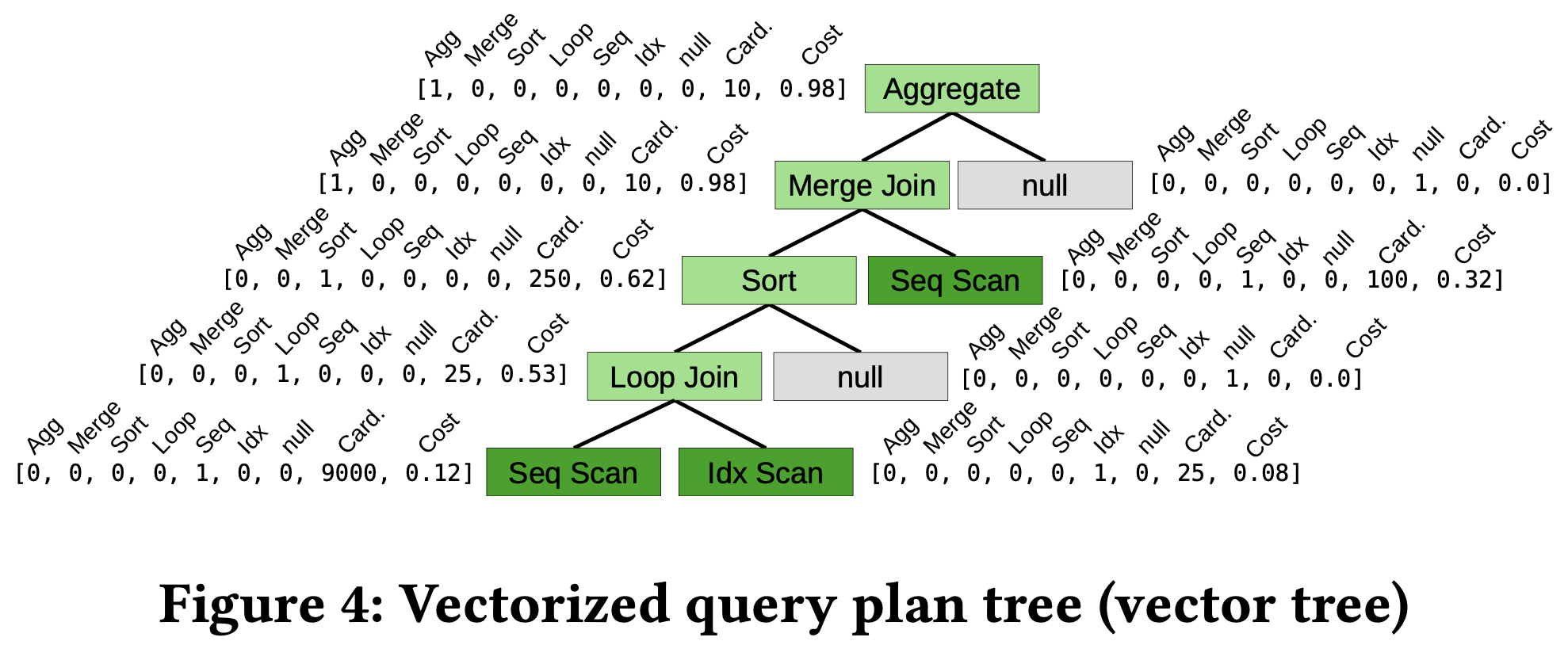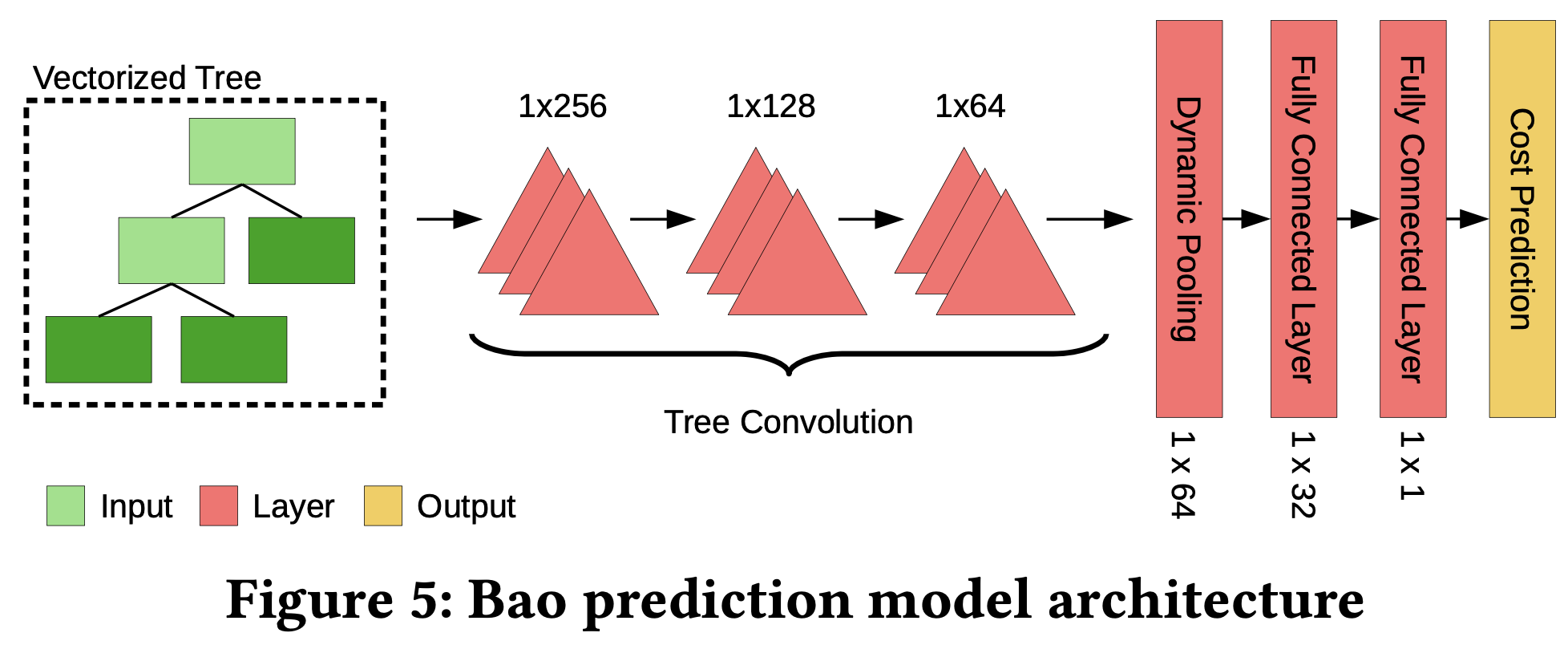[paper summary] Bao: Making Learned Query Optimization Practical
Summary
Bao (Bandit optimizer) is a novel learned query optimization system that addresses the practical limitations of previous machine learning approaches to database query optimization.
Key Problems with Existing ML Query Optimizers
- Long training time - Most ML techniques require impractical amounts of training data
- Inability to adapt - Cannot handle changes in workload, data, or schema
- Tail catastrophe - Can perform catastrophically poorly on some queries (100x regression)
- Black-box decisions - Difficult to understand or debug
- Integration cost - Hard to integrate into real database systems
Bao’s Approach
Instead of learning a query optimizer from scratch, Bao:
- Takes an existing optimizer (e.g., PostgreSQL) and learns when to activate/deactivate specific features
- Uses query hints to guide the traditional optimizer on a per-query basis
- Combines Tree Convolutional Neural Networks (TCNN) with Thompson sampling (contextual multi-armed bandit)
- Treats each hint set as an “arm” in the bandit problem
Key Advantages
- Short training time - Can outperform traditional optimizers in ~1 hour vs. days for other approaches
- Robust to changes - Adapts to workload, data, and schema changes by leveraging traditional optimizer’s estimates
- Better tail latency - Improves worst-case query performance significantly
- Interpretable - Decisions can be inspected and Bao can be enabled/disabled per query
- Low integration cost - Easy to integrate as PostgreSQL extension without code changes
- Extensible - Can add new query hints without retraining
Experimental Results
- ~50% improvement in cost and latency over PostgreSQL across multiple workloads
- ~20% improvement over commercial database system
- Significant tail latency reductions (e.g., 99% latency from 130s to <20s)
- Maintains performance even with dynamic workloads and schema changes
- Converges within 2-3 hours compared to 24+ hours for other learned optimizers
Technical Details
- Uses 48 hint sets covering different combinations of join operators and scan operators
- Vectorizes query plans using operator encoding, cardinality estimates, and optional cache information
- Retrains model every n queries (default: 100) using k most recent experiences (default: 2000)
- Available as open-source PostgreSQL extension
Bao represents the first practical learned query optimizer that successfully addresses the fundamental challenges preventing adoption of ML techniques in real database systems.
Details
1. Introduction
Previous research on query optimization using machine learning had the following problems:
- Long training time
- Inability to adjust to workload changes
- Tail catastrophe
- Black-box decisions
- Integration cost
Bao (Bandit optimizer) leverages information from existing optimizers and sits on top of the optimizer rather than replacing it, providing the following advantages:
- Short training time
- Robustness to schema, data, and workload changes
- Better tail latency
- Interpretability and easier debugging
- Low integration cost
- Extensibility
Bao also has disadvantages:
- Query optimization time increases
- Limited set of hints restricts the action space. Even if hints outside the action space might be optimal, they cannot be learned.
Key contributions:
- Introduce Bao, a learned system for query optimization that is capable of learning how to apply query hints on a case-by-case basis
- Bao outperforms both open source and commercial systems in cost and latency, while adapting to changes in workload, data, and schema
2. Methodology Overview
- When a query arrives
1 2
query = "SELECT * FROM ..." hint_sets = [hint_set1, hint_set2, ..., hint_set_n] # 48 candidates
- The basic optimizer generates plans for each hint set (number of generated plans is configurable)
1 2 3 4
plans = [] for hint_set in hint_sets: plan = postgres_optimizer.generate_plan(query, hint_set) plans.append(plan)
- Sample θ from experience using Thompson Sampling
1
θ_sampled = sample_theta_from_posterior(experience)
- Predict performance for each plan
1 2 3 4
predictions = [] for plan in plans: pred = model(plan, θ_sampled) # Predict all plans with the same θ predictions.append(pred)
- Select hint set with best predicted performance
1
best_hint_set = hint_sets[argmin(predictions)]
- Add actual execution performance to experience
3. Selecting Query Hints
3.1. Structure
3.1.1. Assumptions and Definitions
Modeling hint set as query optimizer
Bao models each hint set $HSet_i ∈ F$ as a query optimizer function:\(HSet_i: Q → T\)
- $q \in Q$: Query space
- $t \in T$ : Query plan tree space
- $HSet_i$: Function that takes query q and returns query plan tree t
- Pass query Q and selected $HSet_i$ to the optimizer to receive plan tree for each hint
- Each query plan tree $t ∈ T$ consists of arbitrary number of operators
- Selected from known finite operator set
- Trees can be arbitrarily large but operator types are predetermined
Selection Function: \(B: Q → F\)
- $B$: Decides which hint set to use given query $q$
- Bao’s goal: Select hint set that generates the best query plan
Performance Metric Definition
- $P$: User-defined performance metric
- Execution time, disk I/O count, etc.
- Measures query plan quality using this metric
3.1.2. Formulation as Regret Minimization Problem
\[R_q = {(P(B(q)(q)) - \min_{i} P(HSet_i(q)))}^2\]- $R_q$: Regret (performance difference) for query q
- $P(B(q)(q))$: Performance of plan created with Bao’s selected hint set
- $B(q)(q)$ : Apply selected hint set($B(q)$) to query $q$
- $\min P(HSet_i(q))$: Optimal performance among all hint sets
3.1.3. Contextual Multi-Armed Bandits (CMABs)
Multi-Armed Bandit Problem
- Agent: Entity that must make repeated choices
- Arms: Fixed number of options
- Context: Situational information given each time
- Reward: Reward received after selection
Operation process:
- Agent receives contextual information
- Selects one of several arms
- Receives payout (reward)
- Receives new context and selects again
- Each trial is considered independent
Goal: Maximize reward (i.e., minimize regret)
Multi-Armed Bandit Problem in Bao
- Arms ↔ Hint Sets:
- Each hint set is one arm
- Context ↔ Query Plans:
- Context: Set of query plans generated by existing optimizer with each hint set
- Agent (Bao) sees all possible query plans and selects one
- Reward ↔ Performance:
- Performance result of executing selected query plan becomes reward
- E.g., inverse of execution time, inverse of I/O count, etc.
Operation process in Bao:
- Query $q$ arrives
- Generate query plan for each hint set $HSet_i$: $t_i = HSet_i(q)$
- Context = ${t_1, t_2, …, t_n}$ (all generated query plans)
- Bao selects one of these plans
- Execute selected plan and observe performance
- Add (plan, performance) pair to experience
3.1.4. Thompson Sampling
Use Thompson sampling for regret minimization of contextual multi-armed bandit
General ML vs. Thompson Sampling
General ML
1
2
θ* = argmax P(θ|E) // Select only the most likely parameter
prediction = model(query, θ*) // Always predict with the same θ*
Thompson sampling
Thompson sampling operates while accumulating experience
- Learn predictive model using experience
- $E$ = [(plan1, actual_performance1), (plan2, actual_performance2), …]
1 2
θ_sampled ~ P(θ|E) // Sample θ from probability distribution prediction = model(query, θ_sampled) // Predict with different θ each time
- Sample parameter theta from distribution given $E$(experience)
- Generate slightly different models trained on the same data
To recommend hint sets, we need performance prediction values for each hint set candidate.
Use performance estimation model $M_{\theta}$:
- Input : plan tree
- Output : estimated performance
- Model parameter $\theta$
1
2
3
# Random sampling with replacement from experience each time
bootstrap_data = random_sample_with_replacement(E, size=1000)
θ_new = train_neural_network(bootstrap_data)
- Sample actual performance values from experience
- Extract $\theta$ by training model on sampled data
- Different $\theta$ emerges each time because sampled data differs
- When data is scarce: Various $θ$s are sampled → exploration
- With little data, $P(θ|E)$ has high variance → diverse $θ$ sampling
- Outliers are more likely to appear distinctly
- When data is abundant: Similar $θ$s are sampled → exploitation
- Sampling from large dataset preserves most patterns
- With abundant data, $P(θ|E)$ has low variance → similar $θ$ sampling
With extracted $θ$, predict performance for all hint sets using the same sampled $θ$ Execute using hint with best predicted performance
3.2. Predictive model $M_{\theta}$ architecture
The core of Thompson Sampling is a model that predicts query plan performance. Bao uses Tree Convolutional Neural Network (TCNN) for this purpose.
3.2.1. Vectorizing query plan trees
Binarization
Problem: Many queries include non-binary operations
- Aggregation, Sorting can only have 0 or 1 child
- Tree convolution is more efficient on strictly binary trees
Solution: Convert non-binary tree to binary tree
1
2
3
4
5
6
Original: Binarized:
Aggregate Aggregate
| / \
Merge Join Merge Join null
| / \
Sort Sort null
- Single child: Add “null” node on the right
- Multiple children: Split into left-deep tree
Vectorization
Convert each node to a vector:
- One-hot encoding of operator:
1 2 3
[1,0,0,0,0,0,0, ...] = Aggregate [0,1,0,0,0,0,0, ...] = Merge Join [0,0,1,0,0,0,0, ...] = Sort
- Cardinality and Cost information:
1
[..., cardinality_estimate, cost_estimate]
- Estimates provided by PostgreSQL optimizer
- Cache information (optional):
1
[..., cache_hit_ratio]
- Cache data ratio for scan nodes
- E.g., 0.32 = 32% is in cache
Final vector example:
1
2
[1,0,0,0,0,0,0, 10, 0.98] = Aggregate, card=10, cost=0.98
[0,1,0,0,0,0,0, 250, 0.62] = Merge Join, card=250, cost=0.62
- Schema-agnostic:
- Does not directly include table/column names
- No need to start from scratch when schema changes
- Data change adaptability:
- Cardinality/cost estimates are automatically updated by PostgreSQL
- Data changes are naturally reflected
3.2.2. Tree convolutional neural networks
Intuition behind Tree Convolution
Human Expert Pattern Recognition:
- “Merge joins pipeline without intermediate sorts” → good performance
- “Hash join over very large relation” → spill risk
- “Merge join on top of hash join” → unnecessary sort
Purpose of Tree Convolution:
- Automatically learn these structural patterns
- Recognize good and bad patterns in query plan trees
TCNN Architecture
- Tree Convolution Layers (3 layers):
- Tree-shaped “filters” scan through query plan tree
- Each layer learns more complex patterns
- Layer 1: Simple operator pairs (hash join + hash join)
- Layers 2-3: Complex structures (long chain of merge joins)
- Dynamic Pooling:
- Flatten tree structure to single vector
- Fixed-size output regardless of tree size
- Fully Connected Layers:
- Pooled vector → performance prediction
- Activation & Normalization:
- ReLU activation functions
- Layer normalization
Inductive Bias
Why tree convolution is suitable for query optimization:
- Specialized for structural pattern recognition
- Naturally matches hierarchical characteristics of query plans
- More effective than simple fully-connected networks
Thompson Sampling
General ML: Find most likely model parameters
- $E[P(θ|E)]$ (modal parameters)
Thompson Sampling: Probabilistically sample parameters
- Sample from $P(θ|E)$ distribution
- Balance exploration vs exploitation
Bao’s Choice: Bootstrap Sampling
- Sampling with replacement of $|E|$ items from experience $E$
- Train neural network with bootstrapped data
- The resulting $θ$ corresponds to a sample from $P(θ|E)$
3.3. Training Loop
3.3.1. Experience Control
Second, instead of allowing $|𝐸|$ to grow unbounded, we only store the 𝑘 most recent experiences in 𝐸.
Train model using stored experience data to extract parameters. As experience size grows, model training cost increases significantly
- Experience E maintains only recent k items (sliding window)
- When new experience arrives, remove the oldest one
3.3.2. Model Retraining Method
By far the simplest technique, which has been shown to work well in practice [63], is to train the neural network as usual, but on a “bootstrap” [15] of the training data: the network is trained using $|𝐸|$ random samples drawn with replacement from 𝐸.
- Perform bootstrap sampling from all current data in E (k items)
- Train neural network with bootstrapped data to obtain new θ
- Draw $|E|$ samples with replacement for training (i.e., sampling with replacement k items from k items)
3.3.3. Retraining Frequency
Instead of resampling the model parameters (i.e., retraining the neural network) after every query, we only resample the parameters every 𝑛th query.
- Retrain model every nth query
- Set n=100 in experiments
3.3.4. Model Optimization
Can trade off model quality and training overhead by changing k and n values
Since database query execution mainly uses CPU while model training uses GPU, when training the model, the training layer can be separated to GPU for training, and once training is complete, the model can be attached to the database.
4. Experiments
4.1. Settings
4.1.1. Datasets
| Dataset | Size | Queries | Workload | Data | Schema |
|---|---|---|---|---|---|
| IMDb | 7.2 GB | 5000 | Dynamic | Static | Static |
| Stack | 100 GB | 5000 | Dynamic | Dynamic | Static |
| Corp | 1 TB | 2000 | Dynamic | Static | Dynamic |
Dataset Characteristics:
- IMDb: Join Order Benchmark extension, introduces new query templates over time
- Stack: Real StackExchange data, simulates data drift by monthly data loading
- Corp: Anonymous corporate dashboard workload, schema normalization after 1000th query
4.1.2. Experimental Environment
- Cloud: Google Cloud Platform N1-4 VM + TESLA T4 GPU
- On-premise: 4 CPU cores, 15GB RAM, Intel Xeon Gold 6230, NVIDIA Tesla T4
- Evaluation: Time series split method (train on past data only, predict future queries)
4.1.3. Model Configuration
- Architecture: 3-layer tree convolution + dynamic pooling + 2 fully connected layers
- Training: Adam optimizer, batch size 16, 100 epochs or convergence
- Parameters: 48 hint sets, window size k=2000, retrain every n=100 queries
4.1.4. Workload Characteristics
- Median latency: 280ms (IMDb), 310ms (Stack), 520ms (Corp)
- 95th percentile: 21s (IMDb), 28s (Stack), 3m (Corp)
- Pareto distribution: 80% execution time concentrated in 20% queries (18%, 23%, 21%)
4.2. Baselines
1. PostgreSQL
- Default PostgreSQL optimizer
- Retuned for each hardware platform
- Applied standard configuration and best practices
2. Commercial System (ComSys)
- Commercial database system
- Configuration verified by professional consultant
- Configured and tuned according to documentation and best practices
- License costs excluded from measurement
3. Prior Learned Optimizers
- Neo: Uses tree convolution, generates complete query plans
- DQ: Deep Q-learning, hand-crafted features + FCNN
4.3. Results
4.3.1. Practicality Results
Cost and Performance (Google Cloud N1-16)
- vs PostgreSQL: ~50% cost and latency reduction (all datasets)
- vs ComSys: ~20% cost and latency reduction
- Results include GPU attachment costs
- Cost impact factors: Execution time reduction by Bao »> optimization/GPU time increase
- Dramatic improvements in tail latency have significant impact
Hardware Scaling (IMDb workload)
- Larger VMs show greater Bao improvement effects (vs PostgreSQL)
- ComSys adapts better to hardware changes
Tail Latency Improvements
- 99% latency: 130 seconds → under 20 seconds (PostgreSQL, N1-8)
- Significant tail latency reduction across all VM types
- Median performance improvement is minimal (<5%)
Training Time & Convergence
- PostgreSQL: Exceeds performance after ~2 hours
- ComSys: Exceeds performance after ~3 hours
- Stable adaptation to dynamic workload changes
Query Regression Analysis
- Only 3 regressions out of 113 JOB queries (all under 3 seconds)
- 10 queries show over 20-second improvements
Optimization Time
- PostgreSQL: Maximum 140ms
- ComSys: Maximum 165ms
- Bao: Maximum 230ms (70ms increase, utilizes parallel processing)
4.3.2. Hint Analysis Results
Best Hint Sets (Top 5 responsible for 93% improvement)
- Disable nested loop join (35%)
- Disable index scan & merge join (22%)
- Disable nested loop + merge + index scan (16%)
- Disable hash join (10%)
- Disable merge join (10%)
Query Plan Impact
- 4271/5000 queries selected different operators
- 3792/5000 queries selected different access paths
- 2110/5000 queries selected different join orders
4.3.3. (Ablation) ML Model Results
Model Comparison (First 2000 queries)
- Bao (TCNN): Best performance
- Random Forest: Significantly lower performance
- Linear Regression: Very low performance
- Demonstrates necessity of complex tree convolution models
Model Accuracy
- Initial Q-error: 3 (relatively inaccurate)
- Even with inaccuracy, prevents catastrophic plan selection
Prior Learned Optimizers vs Bao
- Stable workload: Neo surpasses Bao after 65 hours, 15% better after 200 hours
- Dynamic workload: Both Neo and DQ fail to surpass Bao within 72 hours
- Bao excels in fast convergence and dynamic adaptability
GPU Training Time
- Window size 2000: ~1 minute
- Window size 5000: ~3 minutes
- Cloud environment variability exists
5. PostgreSQL Integration
5.1. Key Features/Implementation
Utilizing Hooks System
- Extends functionality using PostgreSQL’s hooks system
- Easy integration into existing PostgreSQL instances without code recompilation
- Adds new functionality based on function pointers
Per-query Activation
1
SET enable_bao TO [on/off]
- Enable/disable Bao per query
- For short execution time queries, optimization time may exceed execution time
- Preserves existing work by disabling on queries already manually tuned by DBAs
Active vs. Advisor Mode
- Active mode: Bao automatically selects hint sets and learns from performance
- Advisor mode:
- Query optimization using PostgreSQL planner only
- Observes performance of executed queries and trains predictive model
- Provides 3 additional pieces of information during
EXPLAINqueries:- Expected performance of generated query plan
- Hint set recommended by Bao
- Expected performance improvement from that hint set
Triggered Exploration
- Can mark performance-critical queries as “critical”
- Critical queries are periodically executed with all hint sets to collect performance data
- Critical experiences receive higher weights during predictive model retraining
- Prevents performance regression on critical queries, ensuring optimal performance


